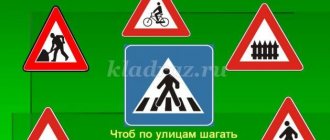Young children have selective attention, lack correct assessment of distance and an unformed sense of self-preservation. These features of the children's psyche are relatively safe at home and on the children's playground, but turn children into the most vulnerable road users. According to statistics, children, the most vulnerable road users, become victims in 3-5% of road accidents, and most often if they find themselves on the roadway unaccompanied by adults.
That is why the task of parents, kindergarten teachers and school teachers is full control of the child’s safety and the utmost seriousness in teaching children the rules of the road and behavior on the road.
Safety rules for children on the road
Children do not need to be forced to learn all the traffic rules, but they should be taught basic safety rules that will preserve their life and health in critical traffic situations. The simplest and most important safety rules for children to remember include the following:
- You should only walk on sidewalks.
- Without adult accompaniment, it is better not to go to the side of the road and not to try to run out onto the road or cross it in places where there is no pedestrian crossing.
- When crossing unregulated pedestrian crossings, you should carefully look to the right, then to the left, be sure to listen and make sure that there is no car dangerously close, and only then cross.
- At controlled pedestrian crossings, you must comply with the requirements of traffic lights (red - stop immediately, green - you can move, but after the cars have completely stopped).
- Do not attempt to cross the road at intersections or turns that are not equipped with pedestrian crossings, where visibility for drivers is limited.
- You must not run, play, hide behind cars or cling to vehicles on the roadway. You should stay away from cars and in yards.
- Standing or stopped cars should only be passed from behind. It is better not to bypass public transport - it is dangerous both in front and behind.
Older children who independently ride bicycles, scooters and roller skates must wear a special protective helmet and move only in safe pedestrian and bicycle zones - on sidewalks, bike paths, in a stadium or in a park. The bicycle must be in good working order, especially the brakes, and equipped with reflective elements (in the evening).
When traveling in a car, children must sit in the back seats, be sure to buckle up and not lean out of the windows. You can disembark only at a planned location (not on the roadway), after the car has completely stopped and under the supervision of an adult.
Two more important rules that must be conveyed to the child: firstly, you should behave calmly on the road and not make sudden movements, and secondly, try to be visible so that drivers can control the traffic situation and react adequately.
Conversation on traffic rules for 3rd grade students. Crosswalk
Summary of an extracurricular lesson on traffic rules: “Types of pedestrian crossings. Rules for crossing the road" (3rd grade, deaf children)
Author: Bestik Irina Viktorovna, teacher of the Regional Special (Correctional) Boarding School for Children with Hearing Impairments, KSU, Republic of Kazakhstan, North Kazakhstan region, Petropavlovsk. Description: a summary of an extracurricular lesson on traffic rules is intended for teachers and primary care educators in correctional boarding schools. Introduces primary school students to the types of pedestrian crossings and the rules for safe street crossing. Goal: to introduce younger schoolchildren to pedestrian crossings. Objectives: educational
- to introduce younger schoolchildren to the concepts of “pedestrian crossing”, “zebra crossing”, and types of pedestrian crossings;
— repeat and reinforce the rules for safe street crossing, — teach how to answer the teacher’s questions, — broaden students’ horizons on traffic rules; educational
- to develop skills for safe behavior on the street in younger schoolchildren, - to instill interest in learning the rules of the road;
correctional and developmental
- to develop students’ logical thinking and memory, - to activate students’ speech during class.
Equipment: multimedia presentation, cards, signs, pictures of pedestrian crossing road signs, glue, pictures for the game. Progress of the lesson: 1. Organizational moment. - Hello guys! - Hello! — Turn on the equipment and put on headphones. — We will listen carefully, talk, answer questions. Working behind a screen.
- First we will do speech exercises.
Speech exercises.
The pedestrian walks boldly along the black and white stripes.
How many of you guys know what the sign warns about? Give the car a quiet ride... (Pedestrian crossing.)
2. Introductory part. — Tell us why you need to know the rules of the road? Children's answers.
- Look at the picture and tell me where it’s safe to play outside and where it’s dangerous.
Why? Children's answers.
— Guys, today we will talk about the types of pedestrian crossings and the rules for crossing the street.
- Open your notebook and write down the topic of our lesson. - What have you done)? — I opened my notebook and wrote down the topic of the lesson. 3. Main part. - Look at the pictures. What is a pedestrian crossing? What types of pedestrian crossings are there? Children's answers.
— There are several types of transitions. The first type of pedestrian crossing is called an underground pedestrian crossing. To avoid getting run over by cars and to avoid trouble, you can cross the road through an underground passage. It is indicated by this sign. Take a picture of the road sign “Underground pedestrian crossing” and paste it into your notebook.
- What have you done)? — I pasted a picture. — Sign the road sign. — I signed (a). — There is a path underground. Even the little ones know about it. In order to cross the road, everyone must walk along it.
— The second type of pedestrian crossing is called an elevated pedestrian crossing. You can cross the road not only under cars, but also above them: on a special bridge - that is, an overhead pedestrian crossing. Glue the road sign “Elevated pedestrian crossing” into your notebook and sign it.
— I pasted (a) and signed (a). — The overpass will never let us down: The road is pedestrian It is always free.
- We will have a rest.
Take off your headphones and stand up. Physical exercise “Pedestrian crossing”.
— The third type of pedestrian crossing is called a ground pedestrian crossing. It is indicated by this sign. This sign tells us where we can safely cross the road. Guys, what is another name for an above-ground pedestrian crossing? - Zebra.
- Why do you think? — Because the zebra horse’s coloring also consists of alternating black and white stripes. — Glue the road sign “Ground pedestrian crossing” into your notebook and sign it.
This sign is of this kind: It is on guard for the pedestrian. We cross the road together with you in this place.
— When crossing the road you need to be very careful and follow the traffic rules. Remember the rules for crossing the road. 1. Approach the road - stop. 2. Before crossing the street, look left, then right. 3. You must wait until the cars stop in front of the pedestrian crossing. Drivers from a distance should notice the pedestrian and brake in front of the zebra crossing. When the cars stop, you can go. 4. You need to constantly look both ways when crossing the road, because the situation on the road may change. 5. If the cars have already left, then wait at the “Safety Island”. — Is it possible to cross the street? - No. You must cross the road at a calm pace, you cannot run!
— Cross the street only at pedestrian crossings!
There is a pedestrian sign, which means the path is open for us. Here is an underground passage, It will take us to our goal, Go down the steps, And don’t be at all scared. And the above-ground one is friends with us. And he will serve as an assistant. - Now we'll play. The game is called "Pedestrian Crossing". Didactic game "Pedestrian crossing". You need to correctly place pedestrian crossing road signs in the picture and sign them. 4. Final conversation. — What did we talk about in class? — We talked in class about the types of pedestrian crossings. Control questions:
— What is a pedestrian crossing? — Name the types of pedestrian crossings — Why is a pedestrian crossing called a “zebra”? — How to cross the road correctly? Walk across the street, pedestrian, where the sign indicates “Crossing!” And always and everywhere follow the Road Code - the traffic rules law! — Close your notebooks. Take off your headphones and you can relax.
We recommend watching:
Scenario of the family competition “Dad, Mom, I am a road family”, grades 3-5 Holiday scenario according to traffic rules for primary schoolchildren Entertainment scenario according to traffic rules for primary school students Game program “Road ABC” according to traffic rules for primary school students
Similar articles:
Extracurricular activity in elementary school according to traffic rules
Scenario for an event on traffic rules in grades 1-2
Traffic rules in 2nd grade. Summary of extracurricular activities
Class hour on traffic rules in 2nd grade. Abstract
Class notes on traffic rules for 1st grade
How to teach road safety rules to young children?
As you can see, there are not many road safety rules for children, and they are not difficult to remember. However, you should always remember that a child of 5 years old does not have clear lateral vision and cannot always distinguish a stationary car from a moving one, and is able to more or less accurately determine the distance to a car on the road at 7-9 years old.
That is, the adequacy of perception of the situation, the ability to simultaneously control several objects and analytically make the right decisions do not work in young children. Therefore, they must memorize traffic rules not on the basis of experience, but “artificially”. And here it is very important to approach learning correctly so that children quickly and efficiently remember information.
- Of course, the best way for children to learn traffic rules is to learn in the family from an early age. First of all, the example of parents who themselves follow safety rules and at the same time explain their actions to their child is important. With repeated, visual and systematic repetition of the rules followed by questioning, parents will be able to quickly determine how much the child understood and remembered the information received. At the same time, attentiveness, discipline, memory and a sense of self-preservation are trained. The ideal form of presenting information is an unobtrusive explanation and game, in which the child remembers important data quickly and confidently.
- At the same time, in the same playful form, children should be taught traffic rules in kindergarten - there is group training, using sets of road signs, and this is also effective: children role-play road situations and learn, quickly adopting knowledge and rules of behavior from each other. In the process, you can use bright books, coloring books, albums and cards on the topic, drawing and learning poetry.
- At school, growing children can consolidate their knowledge at a more serious theoretical and analytical level, especially if real traffic police inspectors are present at traffic lessons. Special entertaining crossword puzzles for children and practical exercises on equipped areas with markings and road signs effectively train skills.
The general process of teaching traffic rules in children's and school institutions should be led by the local traffic police, which prepares training plans for parents, educators and teachers, and also directly participates in the educational process in accordance with existing road accident prevention plans.
With the right approach to the process of learning traffic rules, children by the age of 10-12 are fluent in basic safety rules, are well oriented as pedestrians in a road situation and are able to apply their knowledge in practice. However, it is wrong to stop learning here: periodic repetition of the studied material is necessary until the age of 16, when a person begins to use the information received analytically.
Road safety rules for accompanying adults
The safety of children on the road depends, first of all, on the adults who accompany them. Therefore, it is also very important for parents, kindergarten teachers and teachers to know traffic rules well and strictly follow them.
Pedestrians with children should remember that:
- You can only move on sidewalks and pedestrian paths;
- the child should be carried in arms or led by the hand when crossing roads and streets;
- You can cross the road only at pedestrian crossings (if there are none, on the side of the road towards oncoming traffic).
In a car: the child must be securely fastened (or transported in a car seat), must not be left alone in the cabin, and the doors must be locked. Children should not be allowed to hang out of windows, and when driving, adults should behave as carefully and carefully as possible to eliminate any risk of an accident.
Drivers should remember that in the immediate vicinity of schools, kindergartens, playgrounds and courtyards of multi-apartment high-rise buildings, they should drive slowly and carefully, and the most dangerous period of the year is the school year (especially at night).
In high school
Middle and high school students need a different approach. They also love online interactives and quests, but the presentation can and should be more complicated.
You can talk to teenagers for longer, covering a larger volume of knowledge at a time. Systemic work is also carried out by employees of the State Traffic Inspectorate - they visit schools, conduct lectures, trainings, and simply talk with children. An important role is played by holding “safety minutes” at the end of the school day.
Photo: TASS/Anton Vergun
In addition, older schoolchildren can be involved in working with younger ones - for this there are units of young traffic inspectors (YIT), which appeared in Soviet times.
“Safety is mainly on paper”: what is the cause of accidents with buses
Passenger transport accidents have increased despite stricter safety measures
— Children participate in creative competitions, drive two-wheelers, learn traffic rules, etc. This is a huge movement of interests, which the State Traffic Inspectorate is gradually reforming today so that it also becomes the basis for subsequent education,” noted the president of the expert Natalya Agre.





